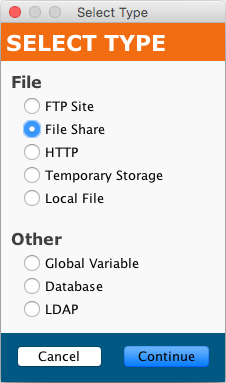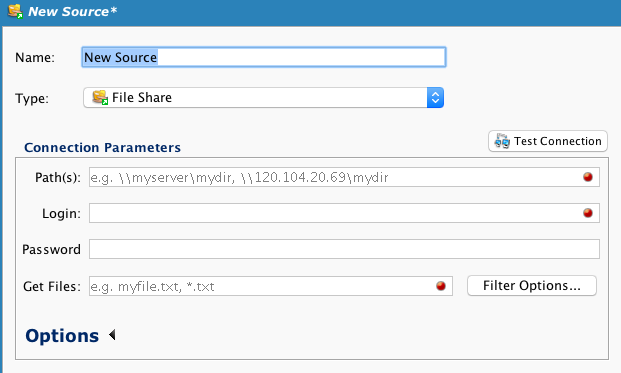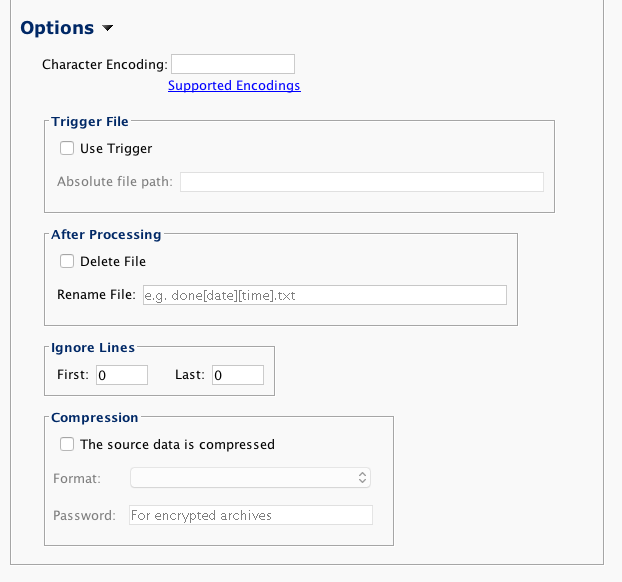Create a File Share source¶
Introduction¶
A File Share source provides access to resources (files and folders) using Microsoft Windows File Share UNC paths.
Prerequisite¶
Before you can use the trigger file feature of a File Share source (see the Options below), you must have enabled Local File Location on your Jitterbit private agent. See Enable local file location for details.
Create a File Share source¶
You can choose to create a new File Share source on its own, or within an existing operation. For more information on how sources work within operations, see Create an operation.
Create a new File Share source as a standalone source¶
Within your project in Jitterbit Design Studio, you create a new File Share source by any of:
-
Go to File > New > New Source; or
-
In the tree on the left, right-click on Sources and select New Source; or
-
In the top toolbar, click the green source icon
 .
.
In the popup, select File Share as the type:

Your new source appears in its own New Source tab in the right pane of the window.
Note
If you create a standalone source using any of these methods, note that it is not connected to an operation. See Use an existing File Share source in an existing operation below to use the new source.
Create a new File Share source in an existing operation¶
A source is usually created by default when you create a new operation. (The exception is an operation that consists only of a script.) With an existing operation, you can specify the type of its source by:
-
Double-clicking on the source icon; in the popup, select Create New Source; or
-
Right-clicking on the source icon and selecting Create New Source.
In the configuration screen that appears, use the Type dropdown to select File Share, as shown above.
Use an existing File Share source in an existing operation¶
To use an existing File Share source in an existing operation with a source, you can set it by any of:
-
Within the operation, double-clicking on the source icon, and in the resulting popup, selecting the desired File Share source from the list; or
-
Within the operation, right-clicking on the source icon, choosing Select Existing Source, and in the resulting popup, selecting the desired File Share source from the list; or
-
Dragging the desired File Share source from the tree on the left and dropping it onto the existing source icon of the operation.
Configure a File Share source¶
After you have created a File Share source, the configuration screen will open in the main view of Design Studio. You can return to the configuration screen at any time by double-clicking on the source icon in the operation, or by double-clicking on the source in the tree on the left.
Basic configuration¶
The configuration screen will appear similar to this example:

-
Name: Enter an appropriate, unique name for the source.
-
Type: Use the dropdown to select File Share, if it is not already specified.
-
Connection Parameters: Specify the details for your local file connection:
-
Path(s): Enter the Universal Naming Convention (UNC) file share path(s) that you want to read from, excluding filename(s). When entering a path, use this format:
\\servername\sharename\path\. In addition, take note:- UNC paths must start with two backslashes
\\but a trailing backslash\is optional (for example,\\dropserver\incoming\po). - An IP address can be used in place of the server name (for example,
\\198.51.100.1\mydir). - Multiple paths can be specified using comma-separated values (for example,
\\myserver\mydir, \\120.104.20.69\mydir).
Important
If using a cloud agent group, UNC paths work only with a public IP address in place of the server name.
All agent groups are limited by restrictions imposed by the file share being accessed:
- They are bound by security and access control set for the user defined in the source or target for that given file share.
- If the file share permits only a certain number of connections, the agent group will be bound to that limit.
- As most file shares do not permit multiple users changing a given file concurrently, if a file is being used by another user or process, the agent group will not be able to change it.
- UNC paths must start with two backslashes
-
Login: If a login is required (in the form of
DomainName\UserName) to access a shared network drive, enter a valid username into the Login field. - Password: Enter a password to use with the Login to access a shared network drive referenced in the Path(s) field.
- Get Files: Enter the name of the source file(s) that you want to read from within the directory specified in Path. This field may also include an asterisk
*to use as a wildcard (for example,*.txtor*.*) or a question mark?to match exactly one character (for example,file?.txt). Variables may also be used in this field. If specifying a compressed file (ZIP), see the "Compression" section of the additional connection parameters under Options below. The compressed file can automatically be uncompressed and read. - Filter Options: Allows specifying if filename case should be ignored or if the Get Files information should be treated as a regular expression.
-
-
Test Connection: Clicking the
 button will test the File Share source; it will fail if the path is not a valid UNC path that finds files on the operating system where the Jitterbit agent is running.
button will test the File Share source; it will fail if the path is not a valid UNC path that finds files on the operating system where the Jitterbit agent is running. -
Click the Save button in either the main toolbar or the target's toolbar to save the configuration.
Options¶
Additional connection parameters can be specified by clicking the Options at the bottom of the Connection Parameters section:

- Character Encoding: Used to specify a character encoding for the source file(s). If left blank, Jitterbit will attempt to detect the encoding. To specify a different encoding than that default, insert one of the supported encodings described in Character encoding.
-
Trigger File: Use this to specify a trigger file to initiate processing of the source file(s). The trigger file is deleted when processing starts.
- After selecting the Use Trigger checkbox, specify an Absolute file path to a file whose presence will trigger processing.
- Variables (though not wildcards) may be used in this field.
- As the trigger file is deleted as processing starts, the trigger file cannot be the same file as a source file being processed.
- Once the operation starts, the operation will poll, looking for the trigger file. Polling time interval is fixed at one second.
- The trigger file is deleted as processing starts.
- If the trigger file is not found, the operation will keep attempting to find the trigger file until the operation times out.
- Setting a trigger file blocks any operation or script that uses the source until either the trigger file condition is satisfied or the operation times out.
-
After Processing:
- If the Delete File checkbox is checked, the source file(s) will be deleted after they have been processed.
- If a value is specified in the Rename File field, the file will be renamed using the pattern supplied. Variables may be used in this field.
- Only one of deleting or renaming is accepted; if the Delete File checkbox is checked, Rename File will be disabled and ignored. If the Rename File is empty, it will be ignored. If left as the default, no post-processing of source files will take place.
-
Ignore Lines: The indicated numbers of first and last lines that are to be ignored for each file. If there are headers or footers to be ignored, enter the number of lines into the First and Last fields as appropriate.
-
Compression: If the checkbox for The source data is compressed is checked, source files will be uncompressed using the ZIP format. A Password (for encrypted archives) can be specified. Encrypted archives are supported if a password is supplied. Only reading from the root directory of the archive is supported.